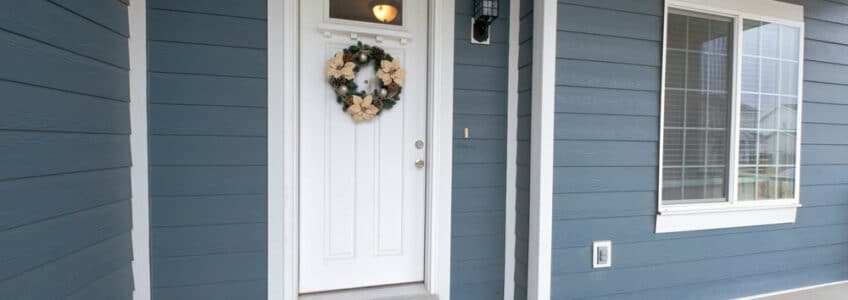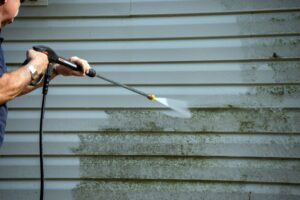
Vinyl siding is among the most common materials for home exteriors in the United States, but it may fade with time like other external surfaces. You’ve come to the correct spot if you’re dealing with mold and mildew and defects like dirt, dust, oil, or rust.
From homemade solutions to a pressure washer, we looked into the best ways on how to clean vinyl siding and you won’t even need to purchase any extra equipment. You’re already good to go, provided you have a basin, hose, and a bristle brush.
How to Clean Vinyl Siding?
Vinyl siding is an excellent option for any home. It’s affordable, attractive, and simple to maintain. If you want your siding to look brand new, you’ll have to clean it periodically. When cleaning, always follow the manufacturer’s instructions and avoid doing anything that might damage the finish.
Here are a few ideas and practices on how to clean vinyl siding to maintain its pristine condition:
Cleaning Process
When you are ready to clean your vinyl siding, a soft cloth or long-handled, soft bristle brush are the best choices. If the vinyl on your home’s exterior is textured, we encourage you to use only a soft bristle brush as this will help keep the grooves stain-free. It’s best to start at the bottom of your home and work up. You must also rinse the cleaning solution completely before it dries. Keep in mind; if your home has brick facing, these surfaces must be covered to avoid discoloration from runoff.
Eliminating Mildew and Mold
If your vinyl siding has mold or mildew, you’ll need to take a more deliberate cleaning approach by using a mold and mildew-killing solution designed exclusively for outdoor use.
If you want to eradicate mold and mildew on your vinyl siding, we recommend using Fantastik® or Windex®. Please always refer to your manufactures cleaning guidelines for best cleaning practices. If you have greenery close to your home, you must wet down or cover the plants before application to safeguard your landscaping.
Removing Mulch Residue
Many property owners use shredded wood mulch for landscaping. Unfortunately, a fungus can live in this organic material which can cause unwanted spotting on vinyl siding. These spots occur from a residue left behind by artillery spores. If you notice spots on your vinyl siding, it’s best to remove shredded wood mulch from your property, replacing it with bark mulch. Next, you will have to replace the siding.
Can I Use a Pressure Washer to Clean Vinyl Siding?

When using a pressure washer for your vinyl paneling, aim the water stream straight at the siding. You risk forcing water behind the rail if you position the flow at an angle. Exercise extreme caution around plumbing systems, doors, and windows on a similar point.
Only use vinyl-safe cleaning products when pressure washing vinyl. Additionally, avoid using a pressure washer with organic solvents, liquid grease remover, bleach, and similar chemicals.
What Cleaners are Safe for Vinyl Siding?
It’s vital that you’re cautious of the type of cleaner that you choose to use when cleaning your vinyl siding as chemical-based solutions can result in discoloration, and even void manufacturer warranty. With any cleaner, it’s recommended that you spot check before using it on a large section of siding. Once a stain is removed, the area must be thoroughly rinsed with water. Below are a few common cleaners that are safe for vinyl siding:
- Dirt and debris: Simple Green®, Nice & Easy®, Armor All®
- Bubble gum: Fantastik®, Murphy Oil Soap®, Windex®
- Crayon: Lestoil®
- Oil-based caulking: Fantastik®
- Felt-tip pen: Fantastik®, water-based cleaners
- Car grease: Fantastik®, Lestoil®, Murphy Oil Soap®, Windex®
- Motor oil: Fantastik®, Lysol®, Murphy Oil Soap®, Windex®
- Paint: Brillo® Pad, Soft Scrub®
- Pencil: Soft Scrub®
- Rust: Fantastik®, Murphy Oil Soap®, Windex®
- Tar: Soft Scrub®
- Top soil: Fantastik®, Lestoil®, Murphy Oil Soap®
Note: It’s vital that you avoid using cleaning solutions containing undiluted chlorine bleach, nail polish remover, furniture polish or cleaners, organic solvents, and liquid grease remover as these products can damage the surface of your vinyl siding.
How Can I Prevent Discoloration of Vinyl Siding?
Vinyl siding discoloration is caused by dirt accumulation and debris accumulation. It’s also possible that you’ve discolored your vinyl siding due to applying pesticides or herbicides too close to it. To extend the life of your vinyl siding, check the labels of any pesticide or herbicide before using it.
Wrap your vinyl siding when conducting other restoration jobs if you have other materials that make up the side of your house. Clean your property using any of the solutions above to remove any preexisting discoloration.
If your siding policy permits, you can repaint your vinyl siding to cover the discoloration.
When Should I Replace My Vinyl siding?
A common question among most homeowners is whether to replace vinyl siding. To assess whether your siding needs replacement, look out for the following key indicators of vinyl siding deterioration:
- There is an indication of moisture inside the house.
- There is considerable rotting of the vinyl siding.
- The vinyl is cracked or loose.
- There are holes in the vinyl siding.
- Your temperature control system bills have increased.
Looking to Replace Your Vinyl Siding?
When washing the siding is no longer an option, it’s time to replace it and siding replacement is a fantastic way to upgrade your home. To replace vinyl siding, contact Advantage Construction for experienced, professional help. Our portfolio of previous work demonstrates our on-the-job abilities. Regardless, the eco-friendly vinyl siding cleansers described above should be in your cleaning cupboard when it comes to upkeep.

